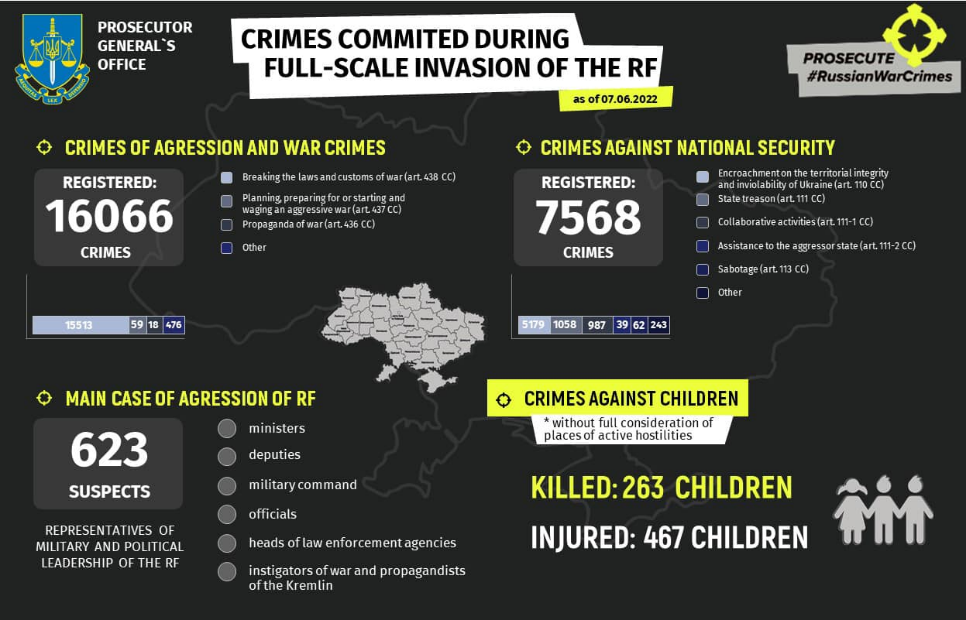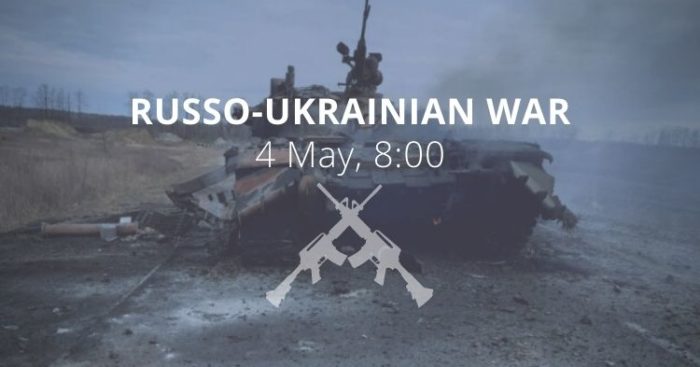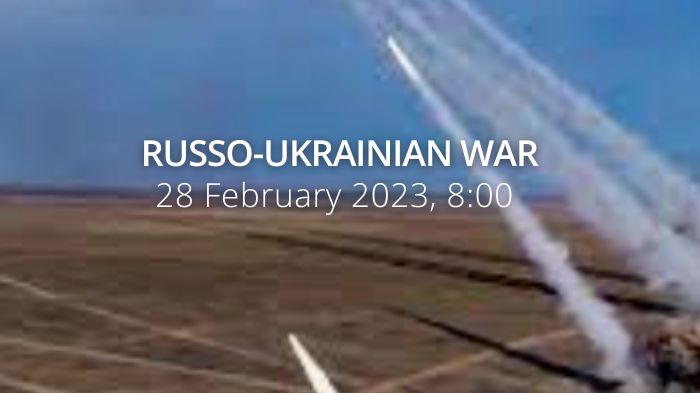Morning report day 104 – June 07
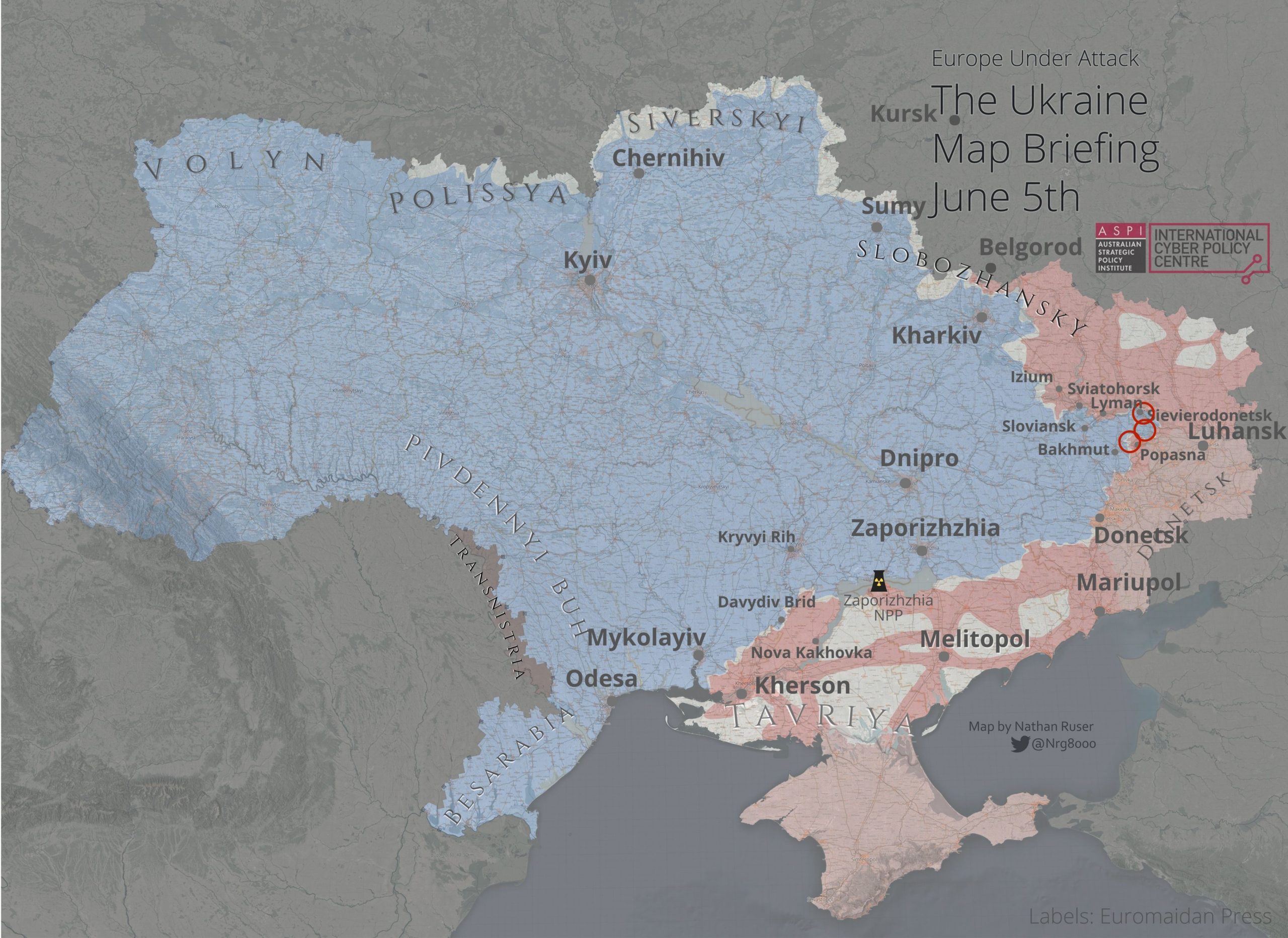
Russia is gathering forces in the Kharkiv Oblast. Most likely, to bind the Armed Forces in the Kharkiv direction (they simply do not have the strength to conduct assault of the city).
In Donetsk Oblast, towards Sloviansk, Russian troops were also attacking Staryi Karavan, Brusivka, and Sviatohisrsk, the last Ukrainian-controlled villages on the left bank of Siverskyi Donets river. Most likely, Russian troops have entered these settlements and are preparing new attempts to cross the river. Also, Russian troops unsuccessfully tried to advance towards Dovhenke from Izium.
https://twitter.com/WarMonitor3/status/1533855801944711170
In Luhansk Oblast, active fighting for Sievierodonetsk continues, and the control of the terrain in the city changes. It is known that Ukrainian forces control industrial districts and at least a few neighboring streets. However, the general situation in Sievierodonetsk looks unpromising for the Ukrainian Forces. They are supplied by a single, damaged bridge.
At the same time, Russian forces continue to press towards Lysychansk from the south. Ukrainian troops lost at least part of Komyshuvaha in this area. The Ukrainian Army is greatly slowing down the advance of the Russian troops but cannot stop them completely. And Ukrainian forces in Horske and Zolote are also under threat of encirclement. The same goes for the Bakmut-Soledar sector -- Russians are advancing very slowly and with losses, but advancing nevertheless.
In the southern frontline, Russian forces have likely retreated from Blahodatne in Kherson Oblast.
The Russian fleet was pushed back 100 km from the coast of Ukraine. Therefore, naval landings are now unlikely. In an attempt to regain control of the northwestern Black Sea, the Russians have deployed Bal and Bastion coastal missile systems in the Crimea and the Kherson Oblast, and are stepping up their forces on Zmiinyi (Snake) Island.
Information from the General Staff as of 06.00 06.06.2022, supplemented by its [18:00 assessment], is in the drop-down menu.
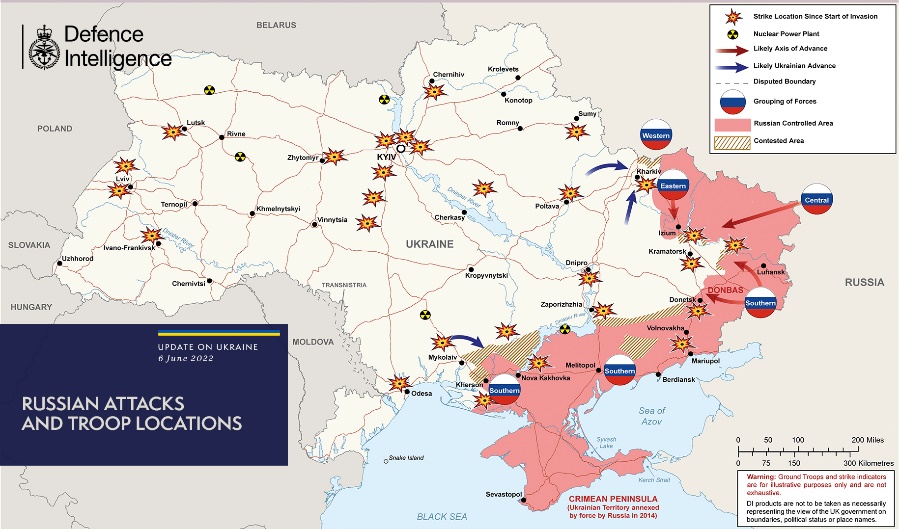
In the Siversky direction, Russian forces did not take active action, and no signs of the formation of strike groups were found. To demonstrate the presence and restraint of the Defense Forces, it continues to maintain up to three battalion tactical groups in the border areas of Bryansk and Kursk oblasts. Mortar shelling of units of our troops in the areas of the settlements of Khodyne and Velyka Pisarivka in the Sumy region was carried out from the territory of the Russian Federation.
- [Russian forces hold separate units of the 20th Combined Arms Army of the Western Military District.]
[In the Slobozhansky direction, Russian forces continue to fight in the border areas north of the city of Kharkiv.]
- [Enemy repair and restoration units are working to restore the destroyed railway bridge over the Oskil River near the Kupiansk-Vuzlovy railway station.]
- [In the Kharkiv direction, Russian forces are conducting defensive battles to restrain the advance of units of the Defense Forces to the state border and to maintain control over the Bilgorod-Kupiansk highway. They carried out remote mining of areas of Shestakove, Peremoha and Bayrak settlements.]. Conducts remote mining of the area in the direction of the offensive of our troops on Rubizhne.
- In the Sloviansk direction, Russian forces are concentrating their main efforts on continuing the offensive in the areas of Izium and Sloviansk. It is trying to move in the direction of Dovhenke and Dolyna. [Yesteday, our units successfully repulsed an assault in the direction of Dovhenke. Inflicted losses on the Russian occupiers. Russian forces retreated. To make up for the losses suffered by the group of troops, it trains personnel on the territory of the Russian Federation.]
- Russian forces are shelling the positions of our troops in the areas of the settlements of Bazalivka, Brazhkivka, and Hrushuvakha. In order to clarify the position of our units and adjust the artillery fire, it conducts air reconnaissance with the use of UAVs.
In the Donetsk direction, in addition to artillery shelling, Russian forces fired from planes and helicopters. The aggressor's main efforts were focused on the Sievierodonetsk and Bakhmut areas. [Measures to restore the combat capability of the occupation units are underway in the Donetsk direction. At some ranges, it was noted that combat operations were coordinated with enemy motorized infantry and tank units, supplemented by mobilized troops.]
- [Russian forces' main efforts are focused on trying to establish full control over the city of Sievierodonetsk and blockade our troops in the area of the village of Lysychansk. Our soldiers are thwarting Russian forces' attempts to take control of the Bakhmut-Sievierodonetsk highway.]
- Russian forces did not wage active hostilities in the Lyman direction. It fired a missile at the village of Mykolayivka, 4 km east of Sloviansk. [Yesteday, to destroy fortifications, Russian forces fired mortars and artillery at our units in the Tetyanivka and Pyskunivka districts. Inflicted a missile strike on Mykolajivka.]
- Russian forces continue to storm the city of Sievierodonetsk, and fighting continues. Our soldiers inflict losses on Russian forces. [Our soldiers maintain control in the city of Sievierodonetsk, fighting continues in the eastern part of the city. Yesterday, they repulsed Russian assault in the direction of Novookhtyrka and Voronovt.]
- In the Bakhmut direction, Ukrainian troops successfully countered and repulsed a Russian offensive in the directions of the settlements of Nahirne, Berestov, Krynychne, and Rota. [Yesterday, Russian forces fired artillery and MLRS, mortars in the areas of the settlements of Berestov, Fedorivka and Myronivka. He conducted a Ka-52 helicopter assault near Roth.]
- Russian forces are redeploying units to strengthen the group in the Popasna and Mykolayivka directions.
- Russian forces did not wage active hostilities in the Avdiivka, Kurakhiv, Novopavliv, and Zaporizhzhia areas.
- [In order to reconnoitre the routes of advance and clarify the positions of our troops, Russian forces use sabotage and reconnaissance groups operating in the area of Belogorovka.]
- [In the Novopavlovsk and Zaporizhzhia directions, Russian forces did not wage active hostilities. He carried out artillery shelling in the areas of Bogoyavlenka, Volodymyrivka, Malynivka and Shcherbakiv.]
- [Russian forces strengthened the grouping of troops by force to the battalion tactical group in the Zaporizhzhia direction.]
In the Pivdennyy Buh direction, Russian forces are concentrating their main efforts on improving its tactical position, maintaining the occupied frontiers, and replenishing ammunition and fuel and oils. Ukrainian helicopters struck at clusters of enemy forces in the Kherson region, and Ukrainian planes attacked ammunition depots in the Mykolayiv Oblast. Russian forces lost more than 20 people and up to 10 units of military equipment.
- To restore the lost position, Russian forces, with the support of artillery and army aircraft, carried out offensive operations in the direction of Lozove - Bila Krynytsia but had no success. To clarify the positions of our troops, Russian forces conducted air reconnaissance of UAVs.
Three carriers of naval-based cruise missiles of the Caliber type are ready for the use of missile weapons in the Black Sea.
Over the past day, the defender of Ukraine in the Donetsk and Luhansk areas repulsed ten enemy attacks and destroyed one tank, three artillery systems, two armoured combat vehicles, one car and two ammunition depots. Air defence units shot down two Orlan-10 unmanned aerial vehicles.”
Battle for Ukraine's Sievierodonetsk rages through the city's streets, Reuters reports. "Ukrainian and Russian troops fought street by street for control of the industrial city of Sievierodonetsk on Monday in a pivotal battle of the Kremlin offensive in Ukraine's eastern Donbas region. Which side had the upper hand was unclear, with "the situation changing from hour to hour," Oleksandr Stryuk, head of administration in Sievierodonetsk, said on television. Stryuk said street fighting was raging and neither side was preparing to withdraw. Both sides say they have inflicted huge casualties on each other.”
Nearly 700,000 Ukrainian servicemen are taking part in the war with Russia, Ukrinform reports. The official recalled that since the beginning of the full-scale war, 40,000 casualties have been recorded on the Ukrainian side, while nearly 3 million citizens remain in the temporarily occupied territories, Deputy Minister of Internal Affairs of Ukraine Kateryna Pavlichenko wrote on Facebook.
"Children who have lost their parents, those who have been forcibly deported, victims of violence… All of them need the help of professional psychologists. Some 700,000 Ukrainian servicemen are taking part in the war. Accordingly, there is a demand for specialized psychologists for combatants and their families," Pavlichenko said.”
Russian occupiers abandon most checkpoints in Melitopol – Melitopol Mayor, Ukrainska Pravda reports. “Russian occupation forces have abandoned almost all checkpoints in the Melitopol district of Zaporizhzhia Oblast for fear of an attack by the Armed Forces of Ukraine, Ivan Fedorov, Mayor of Melitopol, wrote on Facebook.”
Russian warships have been pushed back 100km from the Ukrainian coast, Ukrinform
reports. "As a result of our active actions to strike Russian forces naval forces, the group of warships of the Black Sea Fleet of the Russian Federation was pushed back at a distance of more than 100 kilometres from the Ukrainian coast. Trying to regain control of the northwestern part of the Black Sea, Russian forces was forced to change tactics: deployed Bal and Bastion coastal missile systems in Crimea and Kherson region, redeploys additional forces to Zmiinyi Island," the press service of the Navy Command of the Armed Forces of Ukraine posted on Facebook. As noted, the group of approximately 30 ships and submarines of the Russian Federation continue to block civilian navigation. The situation in the northwestern part of the Black Sea remains difficult.”
Two missile ships and a submarine of the Russian Federation in the Black Sea are ready to attack, Ukrainska Pravda reports. "A naval group of enemy forces continues to blockade shipping in the northwestern part of the Black Sea. Two missile ships and a submarine, which are equipped with 20 cruise Calibre missiles are prepared to attack, [Operational Command South reports]"
- Over the weekend, Ukrainian forces have recaptured parts of Sievierodonetsk although Russian forces likely continue to occupy eastern districts. Russia’s broader plan likely continues to be to cut off the Sievierodonetsk area from both the north and the south.
- Russia made gains on the southern, Popasna axis through May but its progress in the area has stalled over the last week. Reports of heavy shelling near Izium suggest Russia is preparing to make a renewed effort on the northern axis.
- Russia will almost certainly need to achieve a breakthrough on at least one of these axes to translate tactical gains to operational level success and progress towards its political objective of controlling all of Donetsk Oblast.
As of Tuesday 7 June, the approximate losses of weapons and military equipment of the Russian Armed Forces from the beginning of the war to the present day:
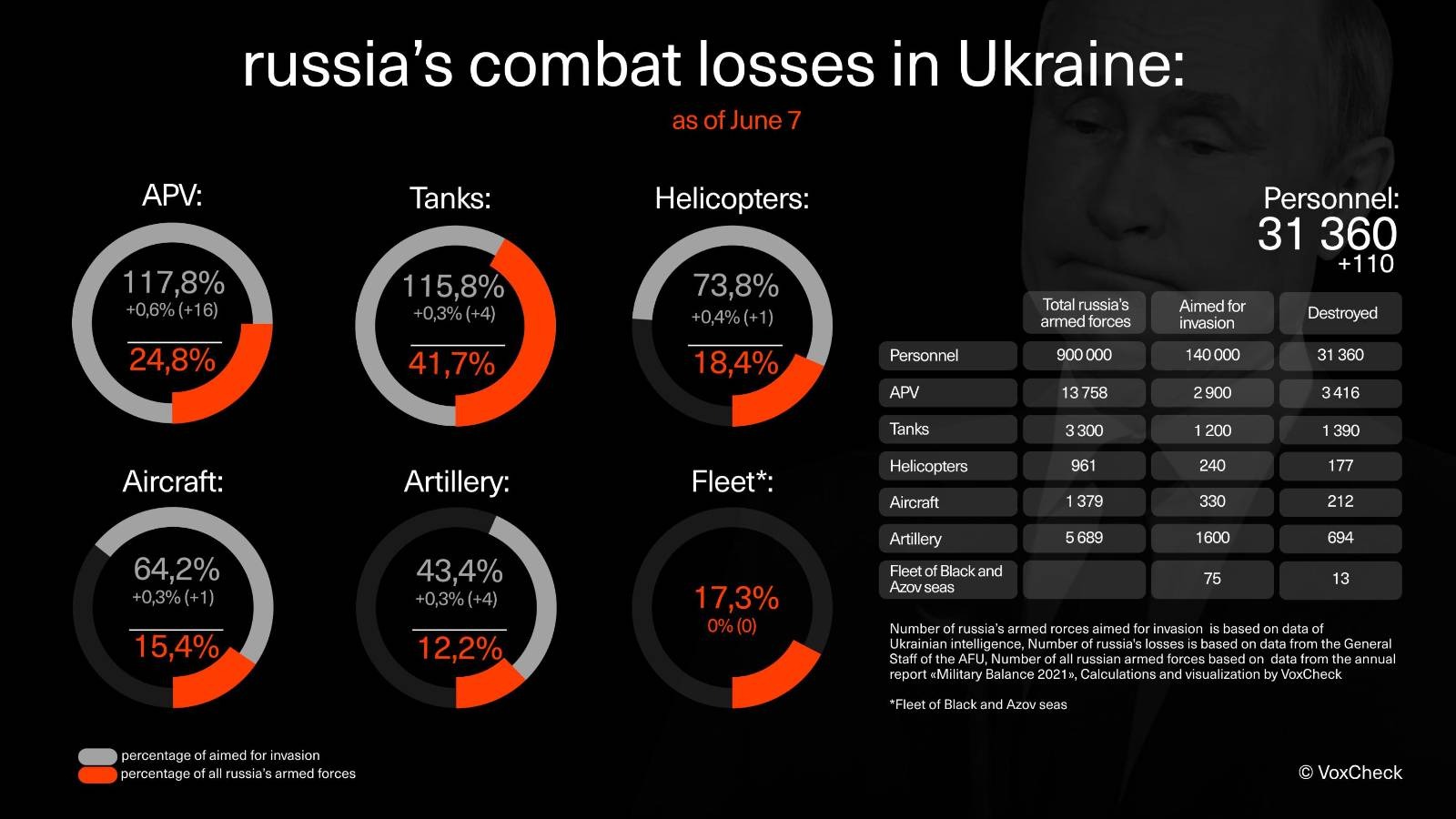
- Personnel – more than 31360 (+110),
- Tanks – 1390 (+4),
- Armoured combat vehicles – 3416 (+16),
- Artillery systems – 694 (+4),
- Multiple rocket launchers –MLRS - 207 (+0),
- Air defence means – 96 (+1),
- Aircraft - 212 (+1),
- Helicopters - 177 (+1),
- Automotive technology and fuel tanks – 2405 (+10),
- Vessels/boats - 13 (+0),
- UAV operational and tactical level – 553 (+2),
- Special equipment – 53 (+0),
- Mobile SRBM system – 4 (+0),
- Cruise missiles – 125 (+3)
Russian enemy suffered the greatest losses (of the last day) in the Slov'yansʹk direction.
Humanitarian
In Kherson, medics massively are refusing to cooperate with Russian invaders, Ukrinform reports. "Doctors in Kherson are massively refusing to cooperate with the occupiers. Currently, there is information that doctors are applying for vacations or filing for resignation to avoid pressure from the Russian military, said Denys Savchenko, Chairman of the Board of CrimeaSOS. This was reported by the CrimeaSOS NGO, according to Ukrinform. It was also reported that local clinics could be turned into military hospitals to treat Russian soldiers. […] It is noted that the situation with medication stocks in local clinics remains unclear. Earlier it was reported that it is critical for the civilian population – about 90% of pharmacies in Kherson and the region have been shut down.”
More than 2,500 Azovstal fighters are held in captivity, Ukrinform reports. "As for the prisoners, there are more than 2,500 of them. It's difficult to say more precisely. This is not the number of people who left Azovstal when we, our side, were involved in this process... Your question was if there are more [than 2,000-2,500] military from Azovstal held in their captivity. I think there are more [than 2,000-2,500], he said."
Zelensky recalled that the Main Intelligence Directorate of the Ministry of Defense of Ukraine is dealing with the issue of releasing Ukrainian soldiers, adding that he is not ready to talk about the details. According to him, the Russians do not torture Ukrainian defenders from Azovstal, because it is not advantageous for them to do so, as our fighters have already become public figures."
A special camp for Russian prisoners of war was created in the west of Ukraine - Minister of Justice of Ukraine, Ukrainska Pravda reports. "We have set up a special camp for prisoners of war in the west of Ukraine, where there are those prisoners of war for whom there are no immediate expectations for exchange. Prisoners of war who have recently been taken prisoner or who may be exchanged in the near future are divided among the institutions of the Ministry of Justice throughout the country, he said.
As for the conditions of detention of Russian prisoners of war, they meet the norms of the Geneva Convention, Denys Maliuska, Minister of Justice of Ukraine, said on the air of a national newscast, Interfax-Ukraine reports. This level is a little better than keeping a prisoner or a convict: a little better nutrition, a little better hygiene, full access to the Red Cross, he said.”
Millions of refugees from Ukraine have crossed borders into neighbouring countries, and many more have been forced to move inside the country. The escalation of conflict in Ukraine has caused civilian casualties and destruction of civilian infrastructure, forcing people to flee their homes seeking safety, protection and assistance the UNHCR reports. They need protection and support. As of 1 June (no update as of 7 June):
Individual refugees from Ukraine recorded across Europe: 4,712,784
- Belarus, Hungary, Republic of Moldova, Poland, Romania, Russian Federation, Slovakia 2,466,377
- Other European countries 2,246,407
Refugees from Ukraine registered for Temporary Protection or similar national protection schemes in Europe: 2,928,252
- Hungary, Poland, Romania, Slovakia 1,278,096
- Other European countries 1,650,156
Border crossings from Ukraine (since 24 February 2022): 6,983,041
Border crossings to Ukraine (since 28 February 2022): 2,102,047
OHCHR recorded 9,197 civilian casualties in Ukraine as of June 2 (no update as of 7 June). 4,183 were killed (including 268 children) and 5,014 injured (including 427 children).
Environmental
IAEA chief working on a mission to Russian-held Zaporizhzhia nuclear plant, Reuters reports. “The UN nuclear watchdog is working on sending an international mission of experts to the Russian-held nuclear power plant at Zaporizhzhia in Ukraine, Europe's largest, its chief Rafael Grossi said on Monday. International Atomic Energy Agency chief Grossi has for months said that the situation at Zaporizhzhia, where Ukrainian staff are working under Russian orders, poses a safety risk and said he wants to lead a mission there.
Ukraine has now indicated that it is concerned about the supply of spare parts to the Zaporizhzhia Nuclear Power Plant (ZNPP), Grossi told a quarterly meeting of his agency's 35-nation Board of Governors, adding that data on nuclear material there was still not being transmitted to the IAEA as it should.”
https://twitter.com/EuromaidanPress/status/1534110923442556932
Legal
The UK provides further support for the investigation into war crimes in Ukraine
, Ukrinform reports. “The UK has responded swiftly to a request from the International Criminal Court for more police and lawyers to aid their investigation into Russian war crimes in Ukraine. Russian forces should know that they will be held to account for their actions and the global community will work together to ensure justice is served,” Deputy Prime Minister, Lord Chancellor and Secretary of State for Justice, Dominic Raab, said. This is stated in the press release published on the website of the Government.”
Sexual violence cases in the Russian war can’t be excused or amnestied - report in UNSC, Ukrinform reports. “The UN Security Council’s documents approved earlier, condemn any forms of sexual violence, which can never be forgiven, justified, or amnestied. That’s according to Pramila Patten, Special Representative on Sexual Violence in Conflict.
Since early June, a monitoring group has received reports of 124 alleged acts of conflict-related sexual violence occurring against women, girls, men, and boys, the rapporteur said, adding that most of the attacks reported targeted women.”
Ukraine demands from Russia humane treatment of POWs – MFA, Ukrinform reports. Ukraine faithfully fulfils all its international legal obligations towards prisoners of war and demands from Russia a mirror treatment of the captured Ukrainian military. That’s according to a statement by the Ministry of Foreign Affairs of Ukraine, Ukrinform reports.
"In the context of full-scale Russian aggression, the Ukrainian state, as a party to the Geneva Conventions of 1949 and its Protocols, has strictly adhered to the principles of hostilities, including international humanitarian law, which includes appropriate rules for the treatment of prisoners of war, the statement said.
It is noted that Ukraine carefully adheres to the provisions of Additional Protocol I to the Geneva Conventions for the Protection of Victims of International Military Conflicts and fully ensures proper treatment of captured Russian servicemen. In this context, the Foreign Ministry noted that the Russian side denounced this important international legal instrument in October 2019. It is now clear that this was one of Russia's preparatory steps for full-scale aggression against Ukraine, the diplomats said. […]
Ukraine continues to faithfully guarantee the minimum required conditions of detention set out in international humanitarian law, the statement said, including accommodation, food, clothing, sanitation and health care, and respect for POW dignity. The Foreign Ministry also stressed that the Ukrainian side provides access to Russian prisoners of war on a regular basis to representatives of international specialized organizations and institutions, including the International Committee of the Red Cross. In Ukraine, the National Information Bureau has been established, which deals with the issues of POWs, including their exchange.
Ukraine demands a mirror-humane treatment of Ukrainian prisoners of war by the Russian side, including the involvement of specialized international institutions to monitor the conditions of their holding in Russian-controlled territories, the Foreign Ministry said. As reported, the Verkhovna Rada Commissioner for Human Rights said on April 24 that Russia was holding captive Ukrainian servicemen in regular penal colonies without converting prisons to POW camps.”
Blinken says reports Russia is 'pilfering' Ukrainian grain for profit are credible, Reuters reports. “US Secretary of State Antony Blinken said on Monday there are "credible reports" that Russia is "pilfering" Ukraine's grain exports to sell for profit. There are credible reports, as we saw in one of our leading newspapers today, that Russia is pilfering Ukraine’s grain exports… to sell for its own profit, Blinken said, an apparent reference to a New York Times story that said Washington last month warned 14 countries, mostly in Africa, that Russia was trying to ship stolen Ukrainian grain to buyers overseas.”
263 children were killed, and 467 children injured, the Office of the Prosecutor General of Ukraine reports as of June 7. 1,940 educational establishments are damaged as a result of shelling and bombings, 184 of them are destroyed fully. 15,842 crimes of aggression and war crimes and 7,457 crimes against national security were registered.
Support
Global interest in the war in Ukraine may slide, Zelensky admits, Ukrinform reports. "There is a new wave today, but there will be a decline in interest in Ukraine because there are many different problems in the world besides Ukraine. Here we need to think before we act of what we can do together thanks to your connections, your daily work, what scheme we should create for this daily marathon to continue… to increase the world's engagement with Ukraine, Zelensky said […] in an interview with journalists on June 6.”
Russia spreading fake news claiming Ukraine selling weapons provided by western partners, Ukrinform reports. “Russian propaganda is trying to discredit Ukraine's leadership by circulating false allegations of Ukraine selling Western defence technology. For the same purpose, Russia-staged provocations are possible in Europe, involving the types of weapons earlier transferred to Ukraine. This was reported on Telegram by the Center for Countering Disinformation at the National Security and Defense Council, Ukrinform reports.”
https://twitter.com/EuromaidanPress/status/1533931746898677762
New developments
- Zelenskyy said that Ukraine is being pushed towards 'peace', but with benefits for Russia, Ukrainska Pravda reports. “President Volodymyr Zelenskyy said that Western politicians and the media are beginning to push Ukraine to end the war with a result that is not beneficial for Ukraine, but Zelenskyy assured that he is not holding such talks with anyone.”
- UK's Johnson and Ukraine's Zelenskyy discuss ways to end the blockade of Ukraine’s ports, Reuters reports. “British Prime Minister Boris Johnson and Ukrainian President Volodymyr Zelensky on Monday discussed efforts to end Russia's blockade of Ukrainian grain exports, a Downing Street spokesperson said.”
- Zelenskyy told what guarantees are acceptable for Ukraine to demine ports, Ukrainska Pravda reports citing Suspilne. President Zelensky “said that the weapons that Ukraine will be able to deploy in the region can be acceptable guarantees for demining ports. We are ready, but we need a security corridor, he said. However, when asked what guarantees are acceptable for Ukraine to demine ports, he said: [We need] weapons that we can deploy in the region. We are working on this and we will get anti-ship missile systems. These are not threats. These will be the best guarantees."
- Kuleba on Putin's promises not to use trade routes to attack Odesa: His words are empty, Ukrinform reports “Putin says he will not use trade routes to attack Odesa. This is the same Putin who told German Chancellor Scholz and French President Macron he would not attack Ukraine — days before launching a full-scale invasion of our country. We can not trust Putin, his words are empty, Kuleba posted on Twitter.”
- Ukraine not invited to Russia-Türkiye talks on grain export via the Black Sea – Zelensky, Ukrainska Pravda reports citing Interfax Ukraine. President Zelensky said that “neither he nor Dmytro Kuleba, Minister of Foreign Affairs of Ukraine, were invited to the Ankara meeting on 8 June, which will address the issue of shipping in the Black Sea.”
- Russia's UN envoy storms out of Ukraine meeting over European statement, Reuters reports. “Russia's UN Ambassador Vassily Nebenzia stormed out of a UN Security Council meeting on Monday as European Council President Charles Michel addressed the 15-member body and accused Moscow of fueling a global food crisis with its invasion of Ukraine. Michel had also accused Russian troops of war crimes and crimes against humanity, specifically citing reports of sexual violence - the focus of the Security Council meeting - and describing it as "a tactic of torture, terror and repression. Mr. Ambassador of the Russian Federation, let's be honest, the Kremlin is using food supplies as a stealth missile against developing countries," Michel said in the Security Council. Russia is solely responsible for this food crisis."
https://twitter.com/EuromaidanPress/status/1534099544614518784
Russia's Perm Representative to the UN left the Security Council meeting room during a speech by the European Council Prez
Charles Michel: "The Kremlin is using food supplies as invisible missiles against developing countries" https://t.co/eKoneFxasc
— Euromaidan Press (@EuromaidanPress) June 7, 2022
Assessment On the War
The Institute for the Study of War has made the following assessment as of Monday 6 June:
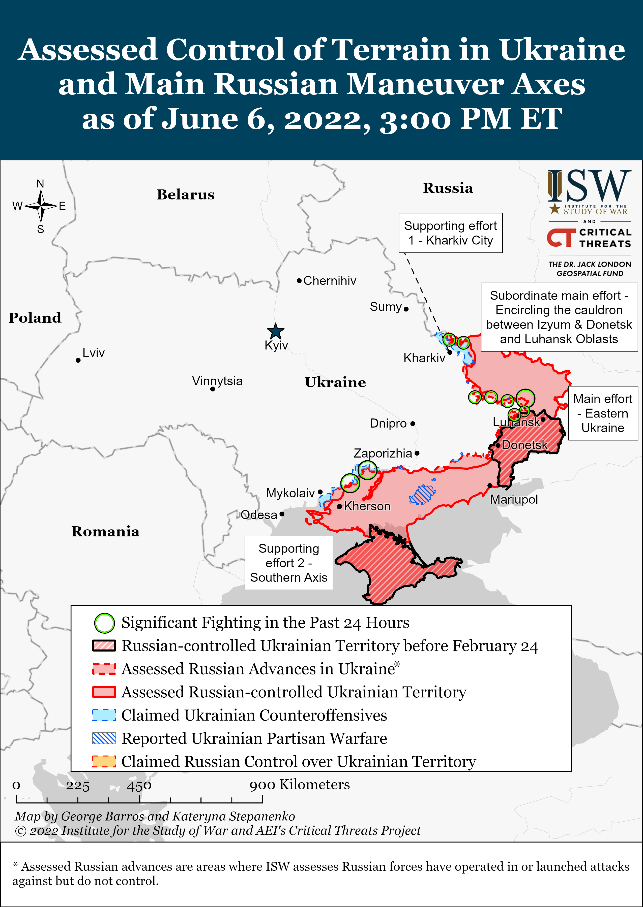
Ukrainian naval forces are challenging Russian dominance over the northwestern part of the Black Sea and claimed to be preventing Russian warships from operating close to the shoreline. The Ukrainian Navy reported on June 6 that they had succeeded in pushing a grouping of the Russian Black Sea Fleet more than 100 km away from the Ukrainian coast but did not specify a timeframe for this statement. The report additionally stated that Russian naval forces have subsequently had to change their tactics in the Black Sea and are relying more heavily on Bal and Bastion coastal defence systems in occupied Kherson and Crimea rather than seaborne air defences. The UK Ministry of Defense claimed that Russian forces have been strengthening their air defence assets on Zmiinyi (Snake) Island, and the Ukrainian Ministry of Defense reported that Russian forces deployed additional S-300 air defence battalions to Crimea. Taken together, these reports suggest that Ukrainian naval pressure and anti-ship missiles—likely including those provided by the UK and other states—have forced the Russian grouping in the northwestern Black Sea to rely more on coastal and air defence as they are pushed away from the Ukrainian shoreline. […].
[ME: ISW makes great assessments of the situation on the ground, but their maritime understanding is, unfortunately, lacking. The Black Sea Fleet is operating further south than it used to during the initial 49 days due to Ukraine’s “newly” established anti-ship missile capability. Their new operating area further away from the Ukrainian coast has no impact on their ability to uphold the maritime blockade of Ukraine or launch cruise missile attacks against military and civilian targets across the country. It only means that the threat of amphibious landing and artillery attacks against targets ashore has been reduced. Moving S-300 to the northern part of Crimea and deploying the system to Zmiinyi (Snake) Island is a logical consequence of losing the cruiser Moskva and its long-range air defence capacity.]
Key Takeaways
- Russian forces likely retain control over most of Sievierodonetsk as of June 6, though the exact situation in the city remains unclear. Control of terrain is likely changing hands frequently.
- Russian forces in the Izium area did not make any confirmed advances, while forces advancing west from Lyman secured minor gains.
- Russian forces continued unsuccessful attempts to sever Ukrainian lines of communication northeast of Bakhmut.
- Limited and localized Ukrainian counterattacks on June 5 forced Russian troops to focus on holding defensive lines north of Kharkiv City on June 6.
- Russian occupation authorities are advancing efforts to issue Russian passports to Ukrainian citizens and cement their control over occupied territories.
- The Ukrainian Navy claimed to have pushed the Russian Black Sea Fleet more than 100 km from the Ukrainian coast, likely to reduce the pressure of the Russian blockade on Ukraine’s southern ports.“
Guerrilla attacks signal rising resistance to the Russian occupation in southern Ukraine, The New York Times reports. “The Kremlin-backed mayor of the Ukrainian town of Enerhodar was standing on his mother’s porch when a powerful blast struck, leaving him critically wounded. A week later, about 75 miles away, a car packed with explosives rocked the office of another Russian-appointed official in the occupied southern city of Melitopol.
By their very nature, the clandestine activities of any insurgency are murky and often impossible to verify independently. It is as much in the interest of Ukrainians to play up talk of rebellion as it is for Russians to play it down. But the explosion that injured the Enerhodar mayor, Andrei Shevchik, is one of more than a dozen high-profile attacks in recent weeks that analysts say indicate increased partisan activity aimed at Russian occupation forces in the Kherson and Zaporizhzhia regions of southern Ukraine. […] In the past month, Ukrainian partisans claim, insurgents have attacked Russian trains and killed dozens of Russian soldiers, as well as supporting the Ukrainian military's counterattacks. Their claims are impossible to independently verify. The partisans also have established a virtual Center of National Resistance, which features instructions for things like setting up ambushes and what to do if arrested. Alexander Motyl, a historian and Ukraine expert at Rutgers University, has scoured publicly available statements about possible insurgent activity. He said that the data suggests it is growing. “It is, of course, possible that Ukrainian special forces may have been involved in some of these actions; it is also likely that the data are incomplete,” he wrote for the online journal 1945. “Even so, the number of guerrilla actions is impressive and bespeaks a trend toward ever-greater partisan activity.” The explosion in Enerhodar and the intrigue that has followed illustrate how Russian efforts to combat insurgency might be deepening the resolve of the partisans. Enerhodar had a population of 50,000 before the war and was home to many of the people who work at the Zaporizhzhia Nuclear Power Plant, Europe’s largest. Residents erected wooden barricades on the road leading into the town in the first week of the war but they proved no match for Russian tanks. Russia took control of the town and named Mr. Shevchik mayor. Then came the blast, which Russia’s RIA Novosti news agency reported on May 22, citing an emergency services source in the city. Ukrainian officials confirmed the incident from their own sources and said that it appeared that the mayor was targeted. Dmytro Orlov, whom Ukraine recognizes as the legitimate mayor of Enerhodar, wrote on Telegram that Russians are trying to tackle the budding insurgency by targeting regular civilians. He said that “the number of abductions of locals has increased significantly” since the explosion involving Mr. Shevchik, and that the humanitarian crisis has worsened. There is almost no Ukrainian currency left in Enerhodar, Mr. Orlov said, adding that since the occupied forces are trying to make Russia’s ruble the only currency, prices for everyday household products have climbed “sky-high.” Reports of Russian soldiers looting mostly abandoned homes are on the rise, while communications in and out of the city have been severed, he said. All this, Mr. Orlov said, will cause the ranks of the partisans to grow. “Even those citizens who had a neutral attitude to the invaders in the beginning are starting to show dissatisfaction with the Russian occupation,” he said. […]”
Consequences and what to do?
Hans Midttun: In the article “Another disappointing war” (The Danish “Weekendavisen” published on 20 May, Andrey Kazankov interviewed the Russian history-interested TV host Kirill Nabutov.
"There were at least three cases in which our country went into what was to be a “small victorious war”, Nabutov said, referring to the famous term used by the Russian leadership during the catastrophic war against Japan (1904 -1905). It roughly corresponds to the German word Blitzkrieg, well known in the West. "The Russians were enthusiastic at the time and were looking forward to breaking the 'little yellow-faced macaques, and the newspapers were drooling over the fact that the Japanese were so weak that they did not even have the strength to raise their rifles," Nabutov remarked and reminded the viewers that the war ended with: The entire Russian Baltic navy was sunk in the Tsushima Strait in 1905, while the naval port Port Arthur and the southern half of the island of Sakhalin were ceded to Japan. Russia's influence in Asia was stifled. And at home, it led to unrest and the first of three revolutions (1905). Then came the mass terror that, along with World War I, eventually led to the downfall of the Russian Empire. The second war that Kirill Nabutov mentions was the Winter War between the Soviet Union and Finland (1939-1940): “The Bolsheviks saw Finland as a little piece of shit. They expected to occupy Helsinki in just one week», the TV host emphasized before coming in on the scale of the disaster: In about 100 days, the Finns killed 1,200 Soviet soldiers per. day. Eventually, Stalin had to give up conquering all of Finland and simply take over a few Finnish territories. At the same time, he pushed the Finns into the arms of German Nazis, with the consequence that Finnish forces later took part in the siege of Leningrad (St. Petersburg), in which up to one and a half million people, mostly civilians, perished And then there was another war, the one against Afghanistan in 1979: “It too was seen as a small challenge that could be solved with a few special forces teams. We just had to change the regime and send in some troops, and then Afghanistan was ours, "Nabutov explained. «But for almost ten years we were so stuck there and at least 15,000 corpses were flown home. In the end, it led to the collapse of the Soviet Union, Nabutov said, looking down in despair.”
Three wars and three humiliating defeats due to Russia underestimating its opponent. Ukraine will be it's fourth.
While many are concerned about the tactical developments on the ground and most experience both exhilaration over successful Ukrainian counter-attacks and despair as the Russian forces push forward, the outcome is given. Russia will never be able to hold the Ukrainian occupied territories over time as the resistance movement is gaining momentum. Ukraine and Ukrainians will continue to fight for their existence because there are no other alternatives. Additionally, a nation shaped by six horrific catastrophic events (War of independence, Holodomor, The Great Terror, WW2, Chornobyl, and the present war) has built resilience and courage that will outlast any Russian attempt to subjugate them.
The Western response to the Russian invasion of Ukraine will help speed up its demise. Its ability to build the military power it needs to remain a global power will slowly disintegrate. The international sanctions might over time even erode the basis for the Russian state. The Russian Federation is isolated from the Western world and is seen as a threat to its security and stability.
The only thing not given is the time needed to defeat Russia. It follows the “wisdom” of the BBC sitcom figure “General Melchett”: “If nothing else works, a total pig-headed unwillingness to look facts in the face will see us through.”
NATO and the USA are the only ones who can influence the time factor. Only when the USA decided to join the war effort during both WW1 and WW2 did the military balance change in favour of the evolving democracies.
When the Second World War erupted in early September 1939, President Franklin D. Roosevelt said:
“When peace has been broken anywhere, the peace of all countries everywhere is in danger.”
Facing the same reservations as the West is expressing today, Roosevelt tried to warn his audience that neither neutrality nor distance could guarantee American security in a globalized world. While he pledged peace, Roosevelt wanted the USA to take a more active role.
Today, NATO and the EU are the audiences. While NATO pledges peace, we need NATO to take an even more active military role in what has become the biggest crisis in international security.
It is time to rise to the occasion and demonstrate the resolve and courage needed. While we are not obliged to defend Ukraine, we are committed to defending ourselves. According to NATO’s strategic concept, that responsibility just happens to start in Ukraine. NATO needs to help Ukraine help us stop Russia at Ukraine’s eastern borders to safeguard our common values and principles. That means we must help Ukraine evict the Russian Armed Forces and break the maritime blockade in the Sea of Azov and the Black Sea.
Unfortunately, if we return to the three Russian planned “small victorious wars” (Japan, Finland and Afghanistan), all ended up fighting Russia alone. The present war should not become the fourth time Russia is left alone to create destruction, atrocities and suffering in a neighbour country. We should be committed to doing the right thing: To follow the core values and principles we claim to adhere to.



